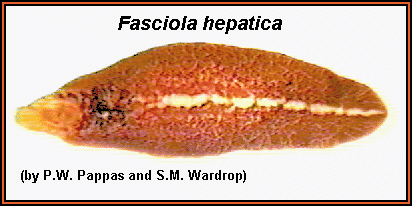
|

|
Flukes are parasitic flatworms, also known as Trematoda. These flatworms have suckers at the mouth that can
attach to blood vessels and allow them to stay in one place despite the blood pressure. Like many other parasites, the number
of hosts it infects through its lifetime varies, although it usually goes through more than one host. These flukes usually
stay near the intestines and, if another fluke of the opposite sex also arrives, reproduce many offspring. These offspring
exit in the feces of its host and, if the larvae reach another host, reach maturity there and another cycle begins. These
flatworms cause sickness, as some could transmit diseases such as schistosomiasis, also known as bilharzia, to millions of
people.

Tapeworms, also known as Cestoidea, are another branch of flatworms, like the flukes. These flatworms have teeth
in addition to suckers that allow it to grab the host. Inside the tapeworms, its bodily structures are spread far out, giving
the worm its ribbon shape. These tapeworms live by absorbing nutrients from the intestines of its host. Also like the fluke,
its life usually involves 2 or more hosts. Some of theses tapeworms infect humans it its life cycle.
An example is the Taenia branch, which includes the beef tapeworm and pork tapeworm. This kind of tapeworm uses humans
as its main host, though it starts with cattle and sheep, and may use dogs and cats as its host too.

|

|

|

